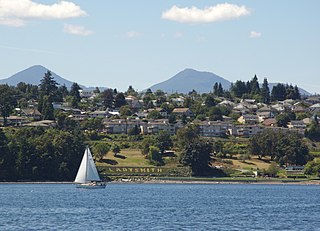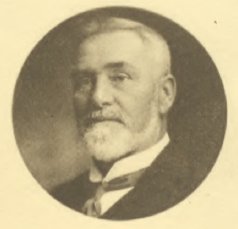
Saysutshun Provincial Park, formally known as Newcastle Island Marine Provincial Park, is a provincial park located on a small island off the coast of Nanaimo, British Columbia, Canada.

Ladysmith, originally Oyster Harbour, is a town located on the 49th parallel north on the east coast of Vancouver Island, British Columbia, Canada. The local economy is based on forestry, tourism, and agriculture. A hillside location adjacent to a sheltered harbour forms the natural geography of the community.

James Dunsmuir was a Canadian industrialist and politician in British Columbia. He served as the 14th premier of British Columbia from 1900 to 1902 and the eighth lieutenant governor of British Columbia from 1906 to 1909.

Albert "Ginger" Goodwin, nicknamed Ginger for his bright red hair, was a migrant coal miner who advocated for workers' rights and promoted the cause of unions in British Columbia, Canada. Angered by the working conditions in coal mines, Goodwin sought to increase wages and improve working conditions, and fought companies that disregarded workers' rights. He participated in and led multiple strikes, and served as a delegate for the British Columbia Federation of Labour and as an organizer for the Socialist Party of Canada. In the years following his increased activism and involvement with labour unions, Goodwin fell under scrutiny for his opposition to military conscription during World War I. He was killed by a police officer in 1918. There is debate on whether Goodwin was a victim of murder or if his death was the result of the officer's self-defence. His death sparked a one-day general strike in Vancouver on August 2, 1918, which was the first general strike ever held in Canada. The strike was a precursor of the Winnipeg general strike of 1919 and other labour conflicts.

The Nanaimo mine explosion occurred on May 3, 1887, in Nanaimo, British Columbia killing 150 miners. Only seven miners survived and the mine burned for one full day.

Robert Dunsmuir was a Scottish-born Canadian businessman and politician.
Cassidy is an unincorporated community straddling Haslam Creek. near the east coast of southern Vancouver Island, British Columbia, Canada. The location on BC Highway 19 is about 98 kilometres (61 mi) by road north-west of Victoria, and 14 kilometres (9 mi) south of Nanaimo.
Union Bay is an unincorporated community located south of Hart Creek on the east coast of central Vancouver Island, British Columbia. This Comox Valley community on BC Highway 19A is by road about 93 kilometres (58 mi) north of Nanaimo, and 14 kilometres (9 mi) south of Courtenay.

Cumberland is an incorporated village municipality east of Perseverance Creek, near the east coast of central Vancouver Island, British Columbia. The Comox Valley community is west of BC Highway 19 and is by road about 105 kilometres (65 mi) northwest of Nanaimo and 10 kilometres (6 mi) southwest of Courtenay.

Morden Colliery Historic Provincial Park is a 4-hectare (9.9-acre) historic provincial park near the east coast of southern Vancouver Island, British Columbia. The location off BC Highway 19 is about 102 kilometres (63 mi) by road northwest of Victoria, and 10 kilometres (6 mi) south of Nanaimo.
The Socialist Party of British Columbia (SPBC) was a provincial political party in British Columbia, Canada, from 1901 to 1905. In 1903, the SPBC won seats in the Legislative Assembly of British Columbia.
The Westmoreland County coal strike of 1910–1911, or the Westmoreland coal miners' strike, was a strike by coal miners represented by the United Mine Workers of America. The strike is also known as the Slovak Strike because about 70 percent of the miners were Slovak immigrants. It began in Westmoreland County, Pennsylvania, on March 9, 1910, and ended on July 1, 1911. At its height, the strike encompassed 65 mines and 15,000 coal miners. Sixteen people were killed during the strike, nearly all of them striking miners or members of their families. The strike ended in defeat for the union.
Wellington, formerly a separate district and town, is a neighbourhood of north Nanaimo, on the east coast of southern Vancouver Island, British Columbia.
John Bryden was a Scottish-born businessman and political figure in British Columbia, Canada. He represented Nanaimo from 1875 to 1876 and North Nanaimo from 1894 to 1900 in the Legislative Assembly of British Columbia.
The Wellington station located in the Wellington area of Nanaimo, British Columbia, was a flag stop on Via Rail's Dayliner service, which ended in 2011. The station is on the Southern Railway of Vancouver Island mainline. The station was named after the town of Wellington which formed around and next to the Wellington Colliery which was named after Arthur Wellesley, 1st Duke of Wellington, a leading British military and political figure in the 19th century.

The Colorado Coalfield War was a major labor uprising in the southern and central Colorado Front Range between September 1913 and December 1914. Striking began in late summer 1913, organized by the United Mine Workers of America (UMWA) against the Rockefeller-owned Colorado Fuel and Iron (CF&I) after years of deadly working conditions and low pay. The strike was marred by targeted and indiscriminate attacks from both strikers and individuals hired by CF&I to defend its property. Fighting was focused in the southern coal-mining counties of Las Animas and Huerfano, where the Colorado and Southern railroad passed through Trinidad and Walsenburg. It followed the 1912 Northern Colorado Coalfield Strikes.
Extension is an unincorporated community near the east coast of southern Vancouver Island, British Columbia. The location off BC Highway 19 is about 107 kilometres (66 mi) by road northwest of Victoria, and 10 kilometres (6 mi) south of Nanaimo.
The Carbon County Strikes took place in Carbon County, Utah from 1903–1904. The strikes primarily consisted of Slavic and Italian immigrant mine workers who partnered with the United Mine Workers of America strikes in Colorado to protest the dangerous working conditions of the Utah coal mines. The Carbon County strikes were considered the most important labor confrontation in the United States at the time. The Utah Fuel Company strongly opposed initiatives to unionize coal workers in Utah and were the primary opposition to the UMWA at the time. The Carbon County Strikes would ultimately fail in its attempt to unionize the coal workers of Utah simply because it "did not have enough support, either internally or externally, to win against a powerful and influential company that effectively played on radical, anti-foreign sentiments in defending its position" but it demonstrated a significant nationwide effort in strengthening unionization in the west.
Nanaimo, British Columbia had four Chinatown sites beginning in the 1800s.












